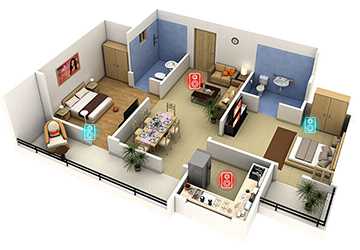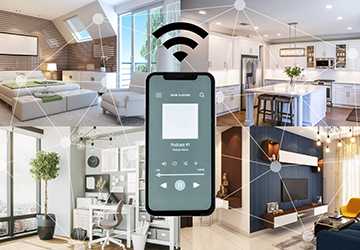Imagine a house filled with the music you love and moving from one room to another with continuous music. Wireless audio systems for homes with multiple rooms have been widely adopted since they enhance comfort and audio quality in the living space.

Modern technology and central control of most multi-room audio systems make installation effortless. With this invention, you can now have your surround sound system at home without obtaining the wires.
This blog post will provide a step-by-step procedure for installing your multi-room audio system. Let's get started!
The Importance of a Multi-Room Audio System
A home audio system is excellent when the house has more than one room and the owner wants to enjoy music in all the rooms. This helps provide a coordinated and integrated musical environment within the home or building.
Different tracks can be played in separate rooms but managed by a single device, such as a smartphone or tablet, in a multi-room configuration.
This is convenient since it implies you can easily switch between tracks, control the volume, or make different playlists for each room.
Whether having a house party, watching a movie with your family, or listening to your favourite tunes, a multi-room audio solution guarantees that the tunes are always within you, anywhere in the house.
Guide to Setting Up Your Multi-Room Audio System
Let's learn how to create your multi-room audio system. This section of the blog post will assist you through the basic steps of building your audio system to make the best possible system.
1. Choose Your Audio System Components
When selecting your multi-room audio system components, consider the following:
Speakers: Depending on your chosen type, speakers are available in wired, wireless, and intelligent forms. Ensure your selected speakers work well with your other equipment and the central unit.
Central Hub/Controller: The 'master control,' in other words, the central controlling hub of your multi-room audio system, could be a Sonos, Bose, or Amazon Echo. It manages and coordinates the audio volume playing throughout all the linked loudspeakers.
Connectivity: Choose components with the extent of connectivity to the available resources like WLAN, Bluetooth, or Ethernet so that the system performs efficiently.
Compatibility: Ensure that the speakers and the chassis are compatible to avoid complications during the assembly and use of the gadget.
Tips for Selection:
● Consider the size and layout of your rooms when choosing speakers
● Allocate a budget for high-quality components to ensure the best audio experience
● Opt for user-friendly systems that are easy to set up and control
2. Plan Your Setup
Room Analysis: Each room's acoustic and spatial characteristics must be considered to cover sound effectively.
Speaker Placement: The following are some tips on where to place the speakers depending on the size of the rooms:
Living room: put the speakers in the centre or the corner for equal sound distribution.
Kitchen: Place speakers on top of cabinets or shelves for sound clarity.
Bedroom: Place speakers on shelves near the bed or walls for a sound experience.
Cabling and Power:
● Prepare for proper cable management
● Make sure each speaker has access to an outlet
● Consider how far away two speakers are from each other and how far they are from the central hub
Sketch a layout of your home to visualize speaker placement and cable routes. Identify power outlets and connectivity points in each room. Consider wireless options to reduce cable clutter and simplify installation.
3. Install and Connect the Speakers
With your plan in place, it's time to install and connect your speakers:
Position the Speakers: Follow the plan and place the speakers in each room in the best position, as determined earlier.
Connect to the Central Hub: Join each speaker to the primary device through Wi-Fi Bl, Bluetooth, or Ethernet, depending on which speaker supports one.

Power On: Connect each one to the socket and turn it on to confirm its operation and readiness for further setup.
Tips for Installation:
● Test speaker placement by playing audio and adjusting as needed for optimal sound
● Label cables clearly for easy identification and troubleshooting
● Follow the manufacturer's instructions carefully to ensure proper installation
4. Configure the Audio System
After installing your speakers, it's time to configure your multi-room audio system:
Set Up the Hub/Controller:
● Download your central hub's appropriate app (Sonos, Bose, Amazon Alexa)
● Create an account and follow the app's setup instructions
● Sync the Speakers: The app syncs all speakers to the central hub, ensuring they are recognized and connected correctly
Personalize your audio experience by:
● Adjusting volume levels for each room or speaker
● Creating audio zones by grouping rooms together
● Setting up voice control, if available, with your system
Tips for Configuration: Use presets to save different listening modes for easy access. Explore the app's features for advanced settings and customization and ensure your system's firmware is up-to-date for optimal performance and new features
5. Test and Optimize the System
Finally, test and optimize your multi-room audio system for the best possible performance:
Test Each Room: Use the speaker to play audio in each room to test whether it has successfully connected to the system and the sound quality it produces. If so, the location of the speakers should be rearranged for better sound quality.
Optimize Sound Quality: Use the equalizer settings to adjust the volume of each room based on the user's preferences. Consider options like soundproofing panels to improve sound quality.
Tips for Testing:
● Test your system with different music genres and audio sources
● Fine-tune settings based on each room's unique acoustics
● Seek feedback from family members to ensure everyone enjoys the audio experience
Start Building Your Multi-Room Audio System Today!
This guide lets you set up the multi-room audio system to your heart's content. Do not let this chance slip by—make smart home audio available to every room in your home—it will improve your home entertainment experience.
Consider the pleasure of having a professionally installed sound system at an affordable price.
Introduce your favourite music, movies, or audio to friends and family quickly. Change a song, movie, or audio with just one gadget across multiple rooms.
Do not delay; begin creating your multi-room audio system right now! It will become something you can only imagine how you manage.
Frequently Asked Questions
Q. Which multi-room audio system is most suited to the inexperienced user?
Ans. Sonos and Bose are easy-to-use systems with exceptional sound quality and are well-suited for first-time multi-room audio system users. They are easy to install and operate, have a simple interface, and are compatible with most existing music streaming platforms.
Q. Is it possible to install speakers of different brands for multi-room audio systems?
Ans. The compatibility and efficiency of the speakers and devices are generally better if they are from the same brand. Still, some systems—for instance, —cans—can be connected to a limited number of third-party speakers through Connect or Port.
Q. How do you control audio in different rooms?
Ans. Many multi-room audio systems have an intelligent application through which you can control the audio output of the individual rooms using mobile devices such as smartphones and tablets. The features include adjusting the volume, switching tracks, and arranging the rooms in groups.


